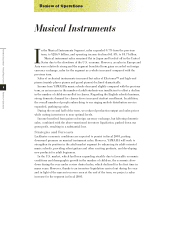Yamaha 2002 Annual Report Download - page 20
Download and view the complete annual report
Please find page 20 of the 2002 Yamaha annual report below. You can navigate through the pages in the report by either clicking on the pages listed below, or by using the keyword search tool below to find specific information within the annual report.
Yamaha Corporation Annual Report 2002
18
The YAMAHA Global Environmental Policy
was first established in 1994. Since then,
YAMAHA has continued to emphasize the
importance of environmental protection
while pursuing a broad range of environmental initia-
tives. In February 2001, in the “Promise to Society”
section of the Company’s new corporate principles,
YAMAHA reaffirmed its commitment to global envi-
ronmental protection and promised to continue the
aggressive implementation of environmental initia-
tives. The YAMAHA Environmental Report, which
was first published in 2000, contains information
regarding the status of the Company’s environmental
program.
1. ISO 14001 Certification
At present, YAMAHA is implementing an environ-
mental management system to facilitate the acquisi-
tion of ISO 14001 certification for all of its domestic
and overseas business units by March 2003.
By March 2001, YAMAHA had achieved certi-
fication for all six of its domestic factories. In Japan,
certification has been achieved for six of the eight
manufacturing affiliates and three of the seven
YAMAHA resorts. Overseas, seven of our fifteen
manufacturing affiliates have been certified. By
effectively employing its environmental manage-
ment system, YAMAHA is conducting its business
activities in an environmentally responsible manner
and striving for continuous improvement in all of
its operations.
2. Environment-Friendly Products
YAMAHA has developed a broad range of products—
including musical instruments, audio and telecom-
munications devices, electronic equipment, and auto-
mobile interior components—and implemented a
product assessment program that reflects the distinc-
tive characteristics of each product type.
Energy Conservation 왘Measures are being taken
to improve the efficiency of such audio products as
power amplifiers as well as CDR-RW drives to
reduce the energy consumption of home theater
systems in standby mode.
Resource Conservation 왘Measures are being
taken to reduce the use of new wood materials through
the development of acoustic guitars made from fast-
growing bamboo and discarded whiskey barrels.
Hazardous Materials 왘Measures are being taken
to use lead-free materials. Examples include a
reduction in the quantity of lead used in solder
materials and the use of lead-free paint on piano sound-
boards. In addition, efforts are being made to reduce
the use of formaldehyde by changing the boards used
inside soundproof rooms.
Green Procurement 왘In 2002, YAMAHA began
implementing a green procurement system calling
for the procurement of safer raw materials to facili-
tate the manufacture of products containing fewer
hazardous materials.
Living Environment 왘YAMAHA has developed
silent acoustic instruments to enhance the living
environments of its customers. Beginning in 1993
with silent pianos, the Silent Series has grown to
include violins, brass instruments, drums, cellos,
violas, Japanese string instruments, and guitars.
Packaging Materials 왘In fiscal 2000, following a
sustained effort, YAMAHA achieved a 68% reduction
in the use of wood-based packaging materials (com-
pared with fiscal 1993). Building on this success,
the Company has set goals calling for the reduction
of foam and vinyl chloride packaging materials.
3. Production and the Environment
Prevention of Global Warming 왘CO2emissions
per unit of net sales decreased 26%, to 15,500 tons
(compared with fiscal 1999).
Protection of Ozone Layer 왘Use of specified
CFCs was discontinued by fiscal 1993. Efforts are
being made to reduce use of substitute CFCs.
Waste Materials 왘A 58% reduction in factory waste
compared with fiscal 1994, with 64% of resources
recycled, was achieved.
4. Social Contribution
Each year during Environment Month*, approximate-
ly 1,000 YAMAHA employees team up to clean lakes
near the Company’s head office as well as the areas
surrounding each YAMAHA factory.
*The Environment Ministry has designated June as Environment Month.
Environmental Activities
Environmental Activities
























